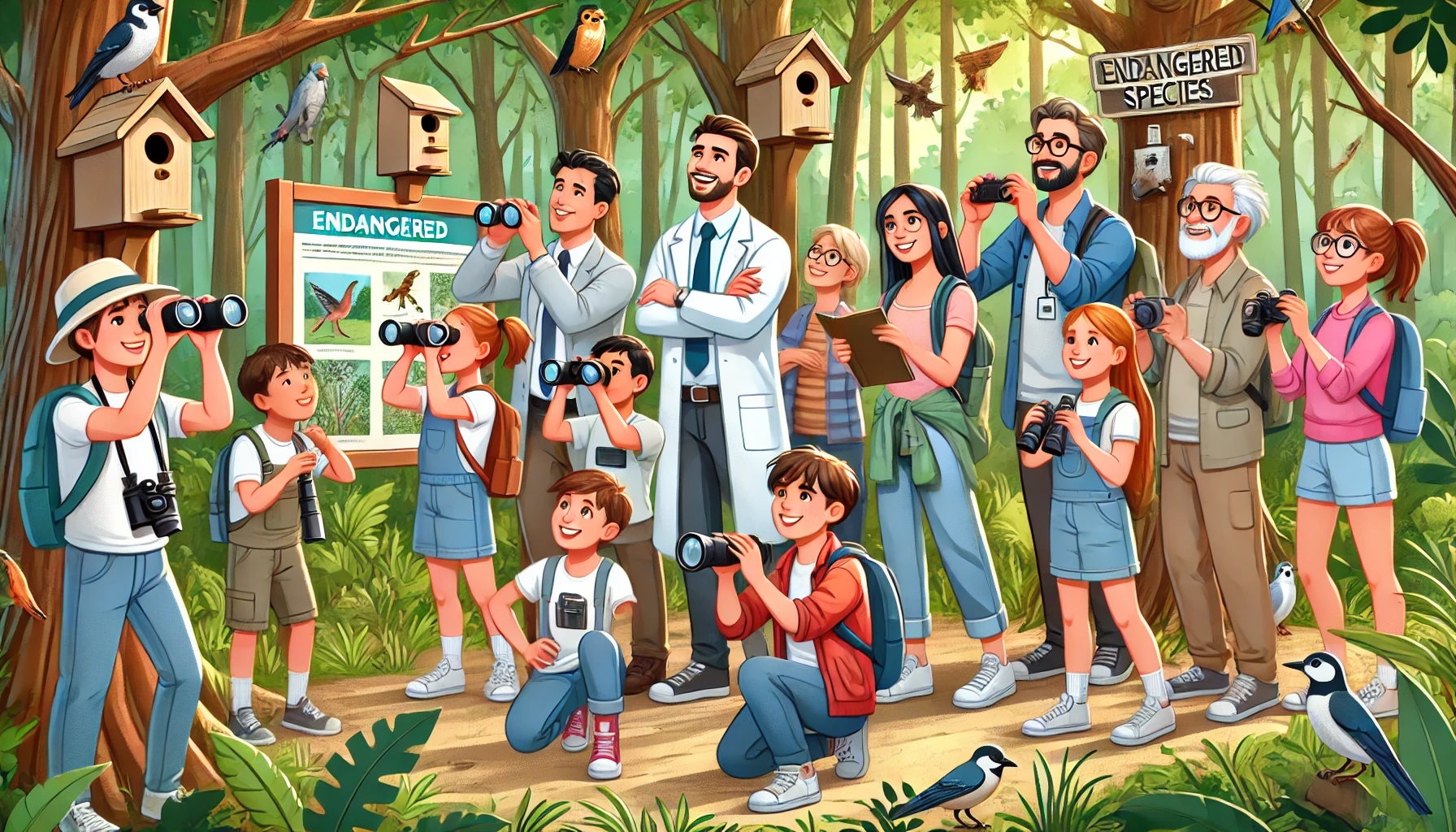In today’s rapidly changing world, the importance of conserving endangered species cannot be overstated. This pressing issue demands a collaborative effort from governments, conservation organizations, and most importantly, the general public. One effective approach to fostering such collaboration is through citizen science, a practice that engages everyday individuals in scientific research and conservation efforts. By involving the public in these critical tasks, we can not only gather valuable data but also raise awareness and inspire action towards protecting endangered species. In this article, we will explore the role of citizen science in endangered species conservation, highlighting its benefits, challenges, and practical ways to get involved.
The Power of Citizen Science
Citizen science is a powerful tool that leverages the collective efforts of non-professional scientists to advance scientific knowledge and conservation efforts. This approach has gained significant momentum in recent years, particularly in the field of endangered species conservation. By enlisting the help of volunteers, researchers can amass large quantities of data across vast geographic areas, something that would be nearly impossible to achieve with limited professional staff.
Engagement and Education: One of the primary benefits of citizen science is its ability to engage and educate the public. When individuals participate in scientific research, they gain a deeper understanding of environmental issues and develop a personal connection to the species and habitats they are helping to protect. This heightened awareness often leads to increased advocacy and support for conservation initiatives.
Data Collection and Monitoring: Citizen scientists play a crucial role in data collection and monitoring. Whether it’s observing bird populations, tracking the migration patterns of marine animals, or identifying plant species in a local park, the contributions of citizen scientists are invaluable. This data is often used to inform conservation strategies, assess the health of ecosystems, and track the progress of endangered species recovery programs.
Getting Started with Citizen Science
Engaging in citizen science is easier than you might think. There are numerous projects and organizations dedicated to involving the public in conservation efforts. Here are some practical steps to get started:
- Find a Project: Begin by researching citizen science projects that align with your interests and local environment. Websites like SciStarter and CitizenScience.gov offer comprehensive lists of ongoing projects across various fields.
- Get Trained: Many projects provide training materials and resources to help volunteers understand the protocols and methodologies involved. Take advantage of these resources to ensure your contributions are accurate and meaningful.
- Participate Regularly: Consistency is key in citizen science. Regular participation helps build a robust dataset and allows you to track changes over time. Whether you commit to daily observations or occasional surveys, your efforts make a difference.
- Share Your Findings: Citizen science is not just about collecting data; it’s also about sharing your findings with the broader community. Use social media, blogs, or local community groups to spread awareness about your work and the importance of conservation.
Success Stories in Citizen Science
Several citizen science projects have made significant strides in endangered species conservation. Here are a few inspiring examples:
eBird: Managed by the Cornell Lab of Ornithology, eBird is a global database of bird observations contributed by citizen scientists. The data collected through eBird has been instrumental in identifying population trends, distribution changes, and conservation priorities for various bird species.
Monarch Watch: This program engages the public in monitoring monarch butterfly populations and their migration patterns. Citizen scientists tag monarchs, report sightings, and help track their journey across North America. The data gathered has been critical in understanding the challenges faced by monarchs and implementing conservation measures.
FrogWatch USA: FrogWatch USA is a citizen science program that encourages individuals to monitor and report on frog and toad populations. By recording the calls of these amphibians, volunteers provide valuable information on their distribution and abundance, helping to guide conservation efforts.
Overcoming Challenges in Citizen Science
While citizen science offers numerous benefits, it also presents certain challenges that need to be addressed to ensure its effectiveness:
Data Quality: One of the primary concerns in citizen science is the accuracy and reliability of data collected by non-professionals. To mitigate this issue, many projects provide comprehensive training and use standardized protocols. Additionally, technological advancements, such as mobile apps and online platforms, help streamline data collection and verification processes.
Volunteer Retention: Sustaining volunteer engagement over time can be challenging. To address this, projects often emphasize the impact of volunteers’ contributions, offer incentives, and foster a sense of community among participants. Regular feedback and updates on the progress of the research can also help maintain motivation and commitment.
Resource Allocation: Implementing and managing citizen science projects requires resources, including funding, staff, and technological infrastructure. Securing these resources can be challenging, particularly for smaller organizations. Collaborations with academic institutions, government agencies, and private sector partners can help alleviate some of these constraints.
How Citizen Science Boosts Endangered Species Conservation
Incorporating citizen science into endangered species conservation efforts offers a myriad of advantages. Not only does it expand the reach and scale of conservation projects, but it also fosters a deeper connection between the public and the natural world. Engaging volunteers in data collection and monitoring provides critical insights that drive effective conservation strategies. By participating in citizen science, individuals contribute to the preservation of biodiversity and help ensure the survival of endangered species for future generations. Moreover, the collective efforts of citizen scientists play a pivotal role in raising awareness and promoting environmental stewardship. This collaborative approach is essential for addressing the complex challenges of species conservation in our rapidly changing world.
How You Can Make a Difference
Getting involved in citizen science is a rewarding experience that allows you to make a tangible impact on conservation efforts. Here are some ways you can contribute:
- Join Local Projects: Many communities have local citizen science projects focused on monitoring wildlife, restoring habitats, or collecting environmental data. Participating in these projects not only supports local conservation efforts but also fosters a sense of community and shared responsibility.
- Utilize Technology: There are numerous apps and online platforms designed to facilitate citizen science participation. Tools like iNaturalist, Project Noah, and Nature’s Notebook allow you to document and share your observations with a global network of researchers and fellow citizen scientists.
- Support Conservation Organizations: Many conservation organizations rely on citizen science data to inform their work. By volunteering your time or donating to these organizations, you can help sustain their efforts and contribute to the broader conservation movement.
Conclusion: The Future of Citizen Science in Conservation
As we look to the future, the role of citizen science in endangered species conservation is set to expand. Advances in technology, increased public awareness, and growing environmental concerns are driving more people to engage in conservation efforts. By harnessing the collective power of citizen scientists, we can accelerate the pace of discovery, enhance our understanding of the natural world, and implement effective strategies to protect endangered species.
Citizen science embodies the spirit of collaboration and shared responsibility. It empowers individuals to take an active role in conservation, transforming passive observers into passionate advocates for the environment. By participating in citizen science, you not only contribute to scientific research but also help build a sustainable future for our planet and its inhabitants.
In conclusion, the engagement of the public through citizen science is crucial for the successful conservation of endangered species. By getting involved, you can play a significant part in ensuring that these species continue to thrive for generations to come. So, why wait? Start your citizen science journey today and be a part of this global effort to protect our precious biodiversity.

